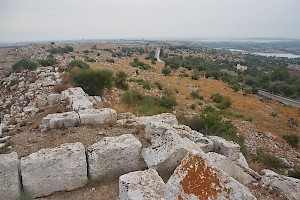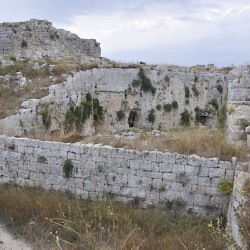Syracuse, Euryalus
Q538394Syracuse: the ancient capital of Sicily.

After Athens' Sicilian Expedition and the Siege of Syracuse (414-413 BCE), it was clear to anyone that the city was vulnerable from the north, where the Athenians and Syracusans had fought a strange war of walling and counterwalling on the Epipolae Platform. Syracuse' new tyrant, Dionysius I, therefore decided to build a wall that surrounded the entire platform, and make Syracuse impossible to take. The photo shows part of the southern wall; the sea can be seen in the distance.
Dionysius had success. Neither the Carthaginians, nor other attackers were able to capture Syracuse. When the city was in 212 BCE eventually taken by the Roman commander Marcellus, treason was involved.
In the far west of the platform, a fortress was built, called Euryalos ("broad based". It is the largest and most complete Greek fortress we know. Dionysius was not the only builder, though. He was responsible for the first building phase, which lasted from 402 to 397, but Agathocles changed part of it in 317, and during the Second Punic War, Hieronymus asked Archimedes to improve the fortifications even more. The Archimedian wall, however, remained unfinished because the Romans took the city in 212.
The fortress was built on a hill that was about 170 m high, which was necessary to expand the reach of the machines that were put on the walls. Dionysius' engineers had invented a primitive version of the catapult, a new weapon that was to change the nature of siege warfare. From now on, high positions were more useful than they had ever been, and to prevent the Euryalus of becoming a battery directed against Syracuse, Dionysius occupied this strategic point.
In front of the battery was a wide moat, which had to be crossed by passing a drawbridge. To the north of the new fort, a small postern gate, hidden behind a wall, allowed for unexpected cavalry attacks on besiegers who came too close to Syracuse's main fort.







